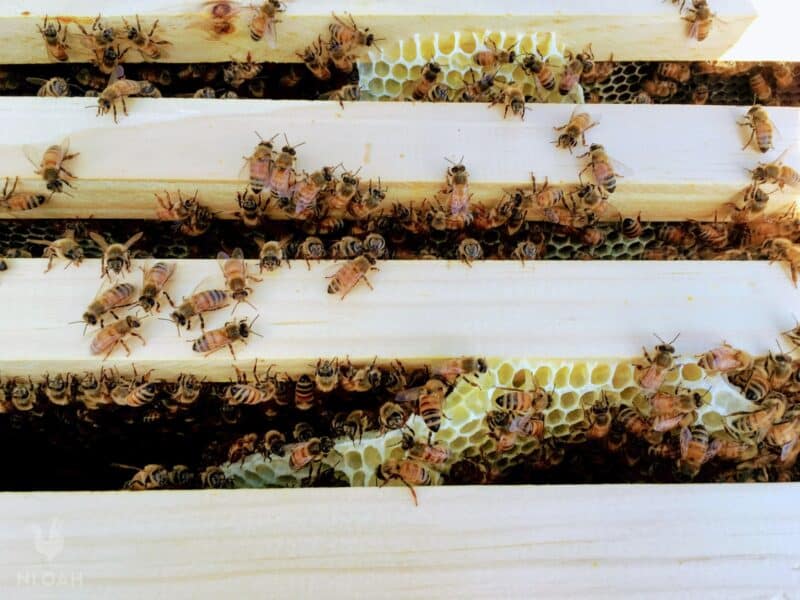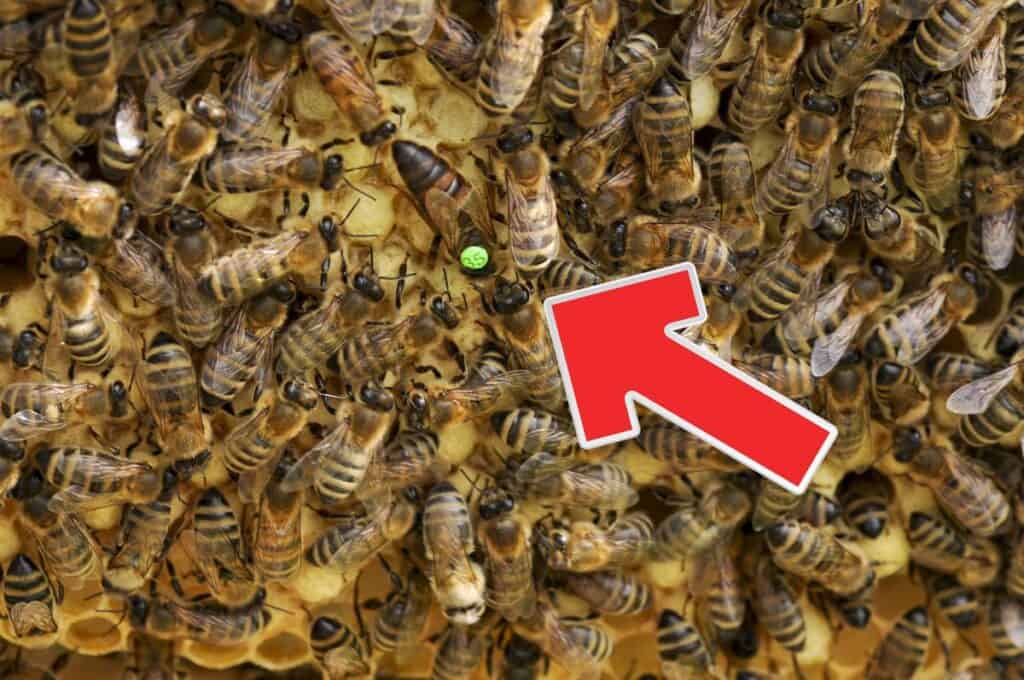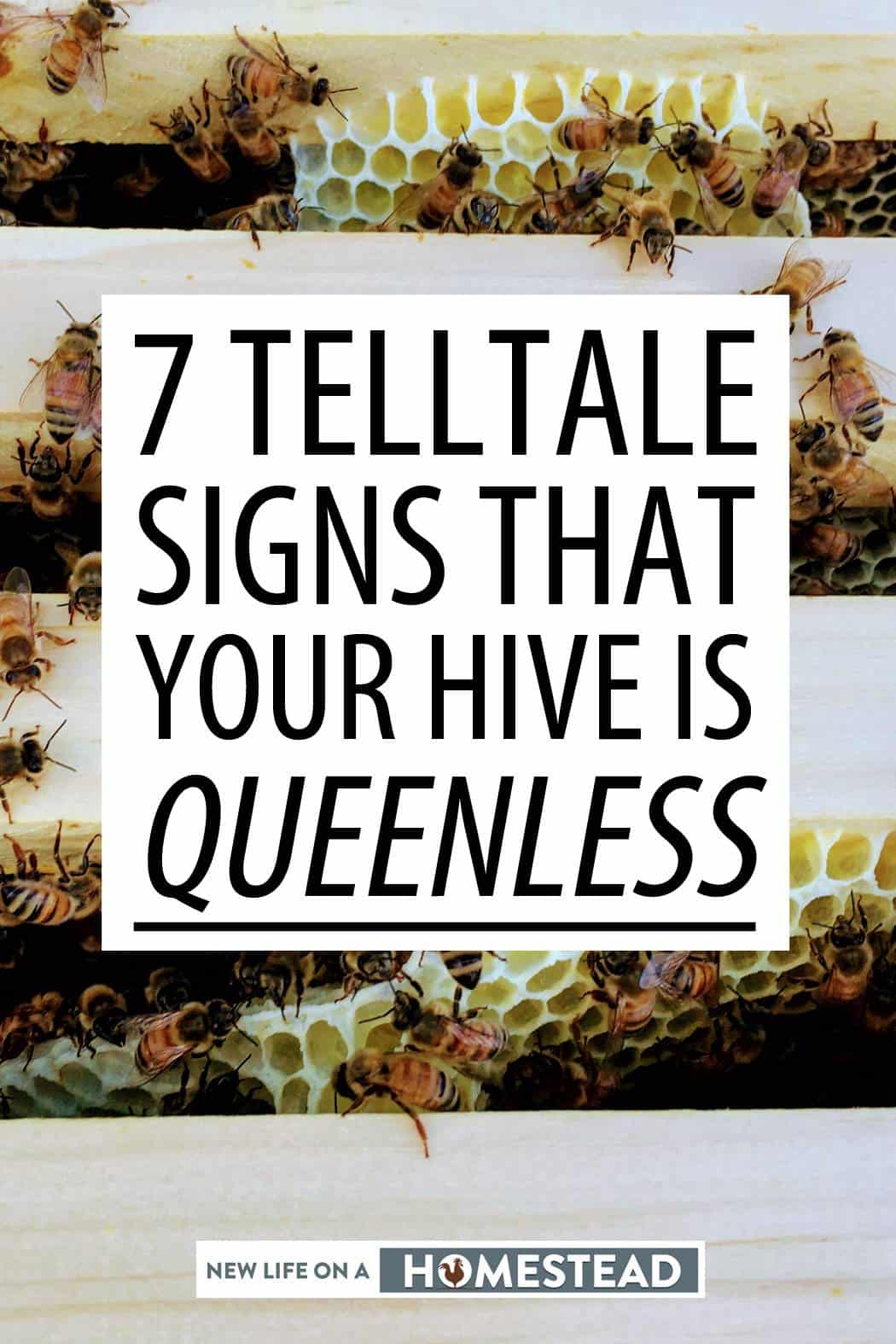Discovering that you have a queenless hive is quite an upsetting set of circumstances. Not only has all of the money you spend on honeybees just gone down the drain, your fruit grove, or garden just lost its pollinators.

While you might think a queenless hive would be both quickly and easily to spot, that surely is not always the case. A honeybee hive without a queen can present with quite subtle changes at first and be rather difficult to diagnose – especially for beekeeping newbies.
If your hive is “queenright”, it will have a brood cell with one tiny little white bee egg in each cell. A hive experiencing queenlessness may still have a few developing bees in a brood cell, but the quantity will dwindle and not be replaced if a queen has died or flown away from a hive colony.
It can take weeks for a queenless hive to completely collapse. Knowing what signs and sounds to watch for on a daily basis can help you realize the queen is dead before it is too late to save the colony.
What Does A Queenless Hive Sound Like?
One of the first ways that you might notice a queen is no longer present in the hive is a difference in the sounds you hear when approaching the hive.
A queenless hive will typically cause the drone and worker bees inside to become nervous, anxious, and irritable. A sound that is akin to a high-pitched whine that is mixed with a low sounding roar can sometimes be heard.
Even if you do not hear this odd mixture of sounds coming from a honeybee hive, it could still be queenless. The sound can be difficult to distinguish, even for veteran beekeepers.
Beware of the Signs
Doing regular hive inspections is essential to make sure your colony is queenright, and that there are fertilized eggs to keep hive production moving forward. Here are some signs you might be missing a queen.
Honeycomb Production
Honeybees will continue to make comb even after the queen becomes ill or dies – for usually a week or maybe two.
It is possible that when you do the typical once a week check on the hive, to still see honeycomb (beautiful and healthy white comb) still being made even after your queen is no longer alive.
Take note (or even take a photo) of the amount of honeycomb your queenright hive is making so you can easily and quickly compare it to the amount of comb production during your weekly hive checks.
The difference in comb production could be slight or substantial, but knowing how much honeycomb is regularly produced when you are certain a queen is active and present, can help you determine if the production is off, when she is not.
Hive Traffic
There is almost always a small cluster of honey bees hovering around the hive entrance from not long after dawn to a little prior to dusk. Pay careful attention to the number of bees in the cluster when the hive has a present and healthy queen.
The number of bees clustering around the entrance will diminish or disappear when the queen is no longer alive. The bees making up the cluster may also look and sound far more agitated than normal once the queen has perished.
Colony Population
In the few weeks that you have to correct a queenless hive, the number of bees present in the hive will likely decrease. Because there is no longer a queen bee to lay eggs, there will not be new bees emerging to replace dying workers.
There will usually first be less nurse bees in the hive because there is no brood to cultivate, but eventually the number of worker bees will dwindle, as well.
Besides an obvious reduction in the number of bees without a queen, you may notice a change to the brood’s temperament, reduced nectar flows, and other signs that requeening needs to happen.
Brood Egg Reduction
The honeybee queen is the only bee in the entire colony that can lay fertilized worker bee eggs. Once the queen is gone, it will be the lack of worker bee brood eggs that you should notice first.
The longer the hive is attempting to function without its own queen, the fewer capped broods (bee larvae) will exist. Every single day that a hive goes without a healthy and functioning queen, the population of the colony will start to decrease due to the short life cycle of worker and drone bees.
If this is something you notice, an emergency queen will be necessary to get the frame of open brood back into production
Increase In Honey Production
In what may seem like an odd twist of fate, a hive that is queenless will produce more honey than it did when a queen was healthy or alive – for a while.
Because there is no mating to do or brood to tend to, the remaining bees busy themselves with collecting pollen and making copious amounts of honey. The hive imbalance usually causes a lot more foraging and chores related to food stores among the remaining members of the colony.
Queen Replacement And Cups Development
A queenless hive almost always tries to create a replacement queen. It is not unusual to see the development of a queen cup (queen cell) inside the colony.
But, simply finding a queen cup, that doesn’t mean you are dealing with a queenless hive. Colonies are prone to creating queen cups for a variety of reasons. This is not a symptom to worry about unless there are other signs that your old queen is no longer there…
Yet, when you see a queen cup inside of the hive AND also notice a distinct lack of a frame of young brood being developed, that’s a pretty solid sign that you no longer have a queenright hive.
Look carefully at the queen cup to see if it is empty, showing signs of growing or hatching, and to determine if it is actually capped. If these signs are present, the colony is most likely queenless and in the process of attempting to hatch a new queen.
Worker Bees Laying Honey Bee Eggs
Once a hive has become queenless for too long, the worker bees will start laying eggs. Once this type of activity occurs, it is incredibly hard to save the hive and make it queenright again. If worker bees are laying eggs they generally place more than one egg in each comb cell.
A honeybee colony with laying worker bees almost always attacks and kills any new queen bee you attempt to introduce – or are hatched. At this stage of queenlessness in a hive, even seasoned beekeepers usually decide the colony is a loss and cleans out the hive.

How Long Before A Virgin Queen Starts Mating?
If you caught the queenlessness of a hive early enough and are introducing a new queen to attempt to make it queenright again, you have about six days from the time she arrives/matures before mating flights begin to take place.
The new queen usually mates with about 10 drones in a short amount of time. About two to three days after beginning the mating ritual, the first eggs should start to appear.
How Long Can A Beehive Be Queenless?
Technically, as long as you are able to place a new brood filled honeycomb into the hie every week or two, the rest of the colony members may stick around to tend to it.
But, you would have to possess another hive that was robust and healthy enough to do this and it would not be sustainable for long.
If you get lucky using this old beekeeper’s trick, there may be enough time to introduce a new queen into a queenless hive before the remaining colony members swarm away.
It would require one to two frames of either emerging or capped brood to even have a chance at sustaining an active and queenless colony before it reaches a point of decline that it would not come back from without the introduction of a new queen or the emergence of a virgin queen bee.
Can You Start A Beehive With Just A Queen?
A honeybee hive can be started with just a mated queen. The queen will eventually die, but you now have the makings of a new hive that a virgin queen can emerge from in the near future.
Still, this is a slow process and one that has to be expertly timed in order to save the hive and make it a queenright colony once again. Place a new nuc of bees into the hive to get it working properly. Again, this is the best and quickest way to save a hive that has gone from queenright to queenless.
Should you be fortunate enough to catch the queenlessness in the early stages and have another hive to pull a frame of brood from, placing it in the failing hive may naturally and quickly salvage the colony.
If the bees in the hive start to build queen cells on the brood, they are well on the way back from the brink of disaster.
How Long Can a Hive Be Queenless?
Just because your hive doesn’t have a queen doesn’t mean they don’t have any leaders. In fact, many hives become surprisingly well-organized in the absence of their queen. Worker bees will take over her role and create order out of chaos – something that scientists refer to as “anarchy without disorder”.
But unfortunately, this order won’t last forever – without an official leader present to lay eggs, most colonies will die off after around 40 days.
If your hive has been queenless for more than 15 days but less than 40 days and you want to get them back on track quickly, then you can purchase a new queen from your local beekeeping supplier or online store.
However, if you don’t want to buy a new queen there are other options available as well! You can try introducing another colony into your existing one (known as “budding”) or even combine two colonies together (known as “grafting”). Both options should help jumpstart productivity in your newly formed colony!
How Long Does it Take a Queenless Hive to Make a New Queen?
The first step in the queen bee-coming process is for the worker bees to select a few larvae from the hive that are only 3 days old or younger.
These larvae will then be fed an exclusive diet of royal jelly, which helps them grow larger and faster than other worker bees. The larva that grows the fastest will become the new queen and will eventually replace her predecessor.
Once she has been selected, it takes another 5 days for her to develop into a mature adult bee. During this time, she’ll still be in her larval stage and can’t fly or lay eggs yet.
After those five days have passed, she’ll finally reach adulthood and take her rightful place as the leader of the hive. This entire process can take anywhere from 8-10 days depending on how quickly she develops into an adult bee.
But it doesn’t end there! Once she’s reached adulthood, she’ll still have some work to do before being accepted by all of her fellow bees.
She must go on several mating flights in order to collect enough sperm from male drones in order to fertilize her eggs — without these trips, she won’t be able to produce any offspring and keep the colony going strong. All said and done, it can take up to 6 weeks for your queenless hive to successfully produce a new queen bee!
Will Bees Bring Pollen To A Queenless Hive?
Yes, usually … at least for a little while. Honeybees in a queenless hive collect pollen out of habit to satisfy their natural desire to provide for the hive.
The bees will go on foraging daily to collect pollen and nectar just as they would if living in a queenright hive – until a new queen arrives or emerges from brood or they give up on the queenless hive and swarm away.


Tara lives on a 56 acres farm in the Appalachian Mountains, where she faces homesteading and farming challenges every single day, raising chickens, goats, horses, and tons of vegetables. She’s an expert in all sorts of homesteading skills such as hide tanning, doll making, tree tapping, and many more.
